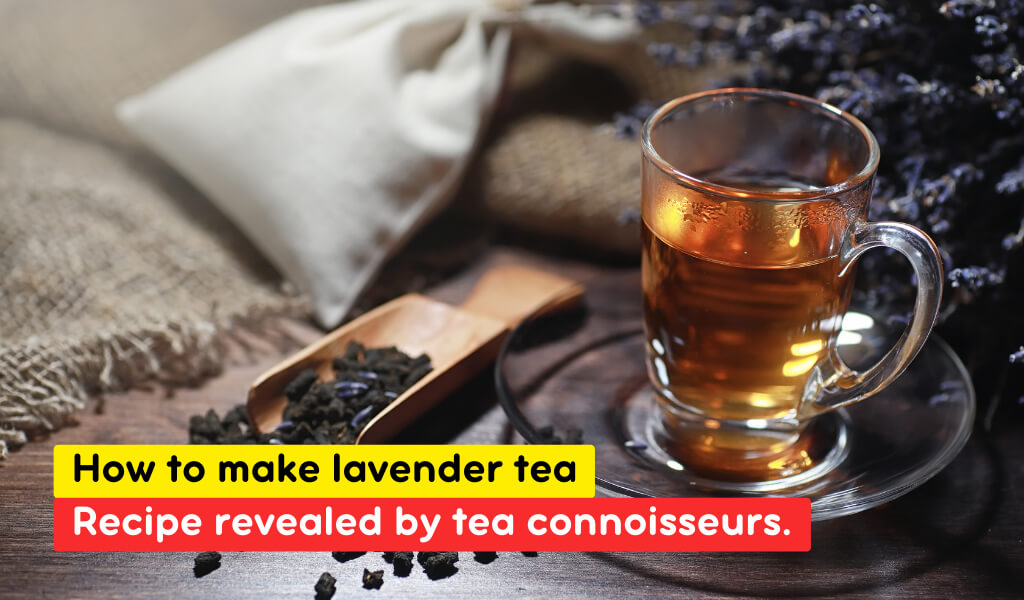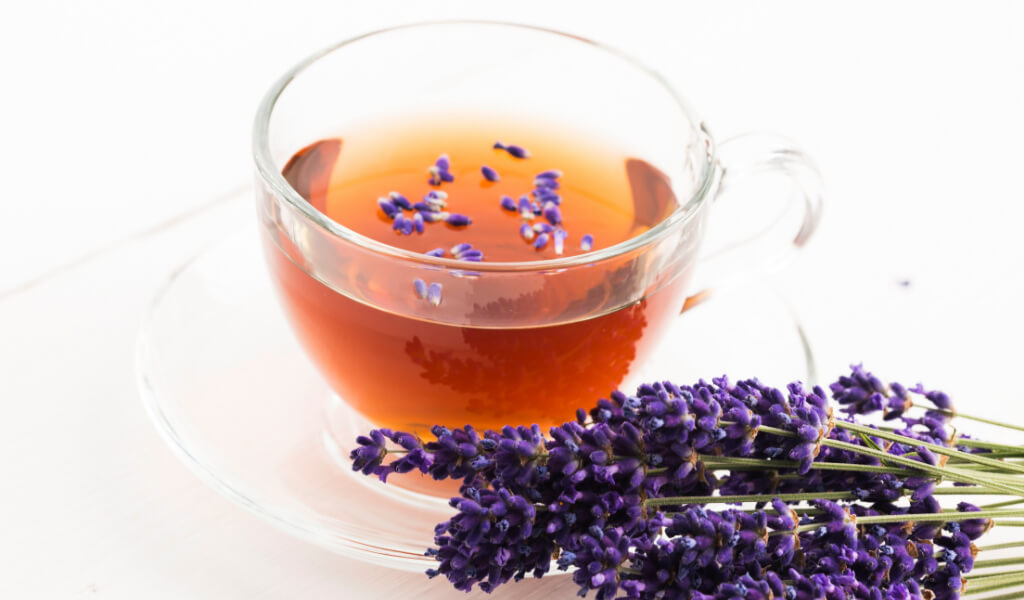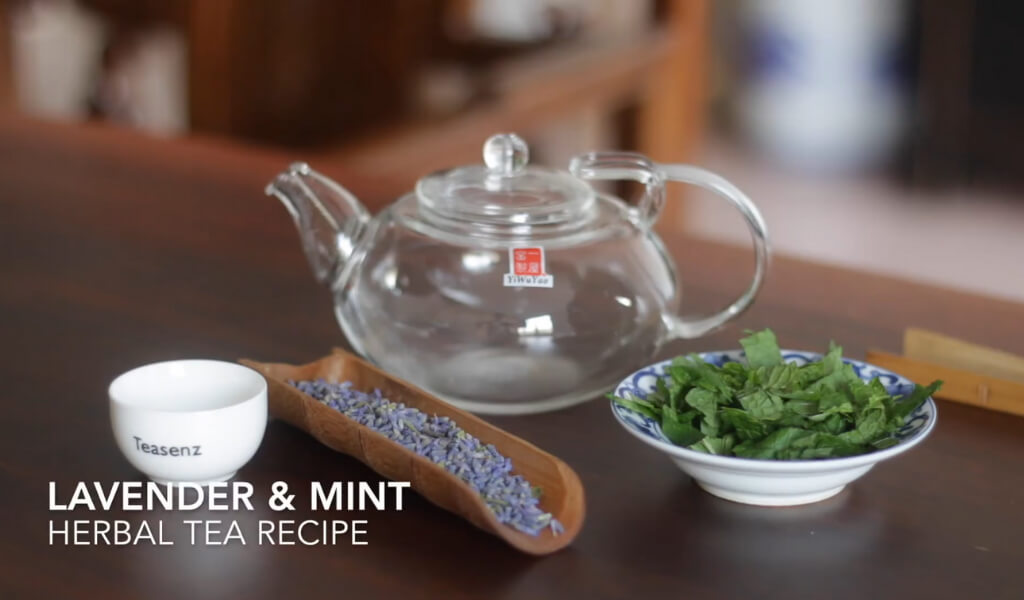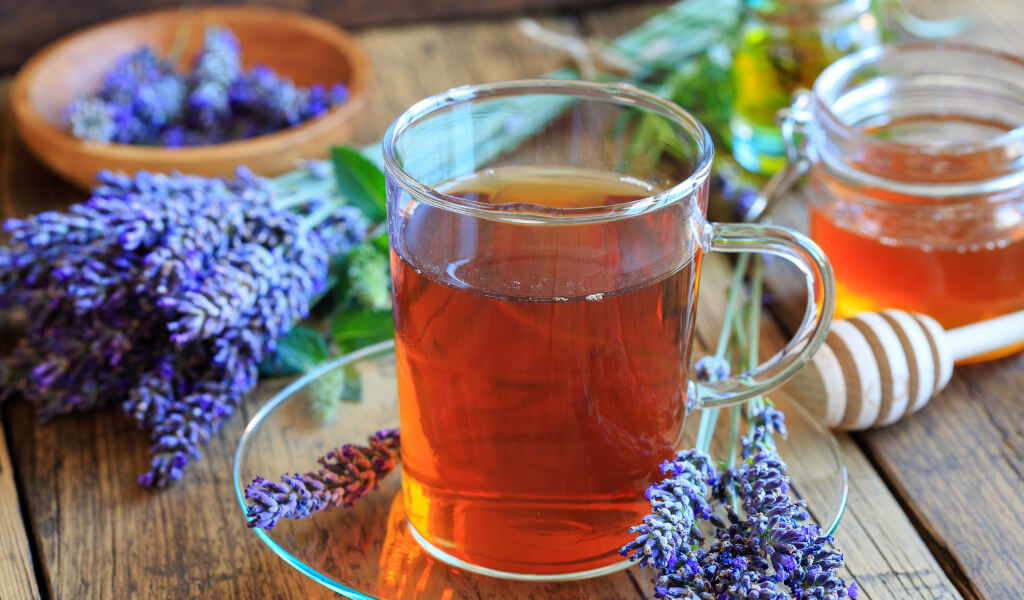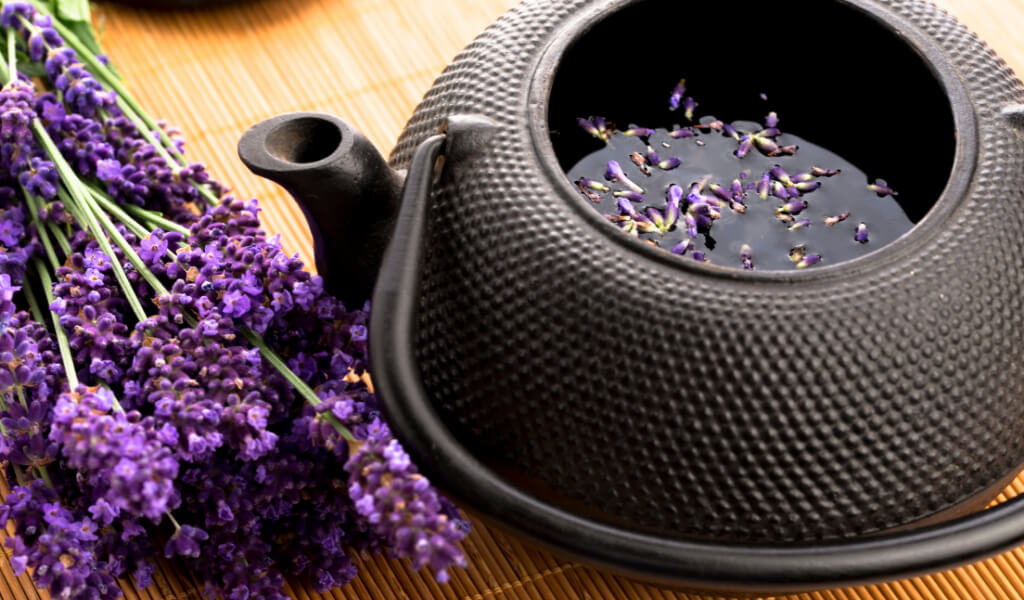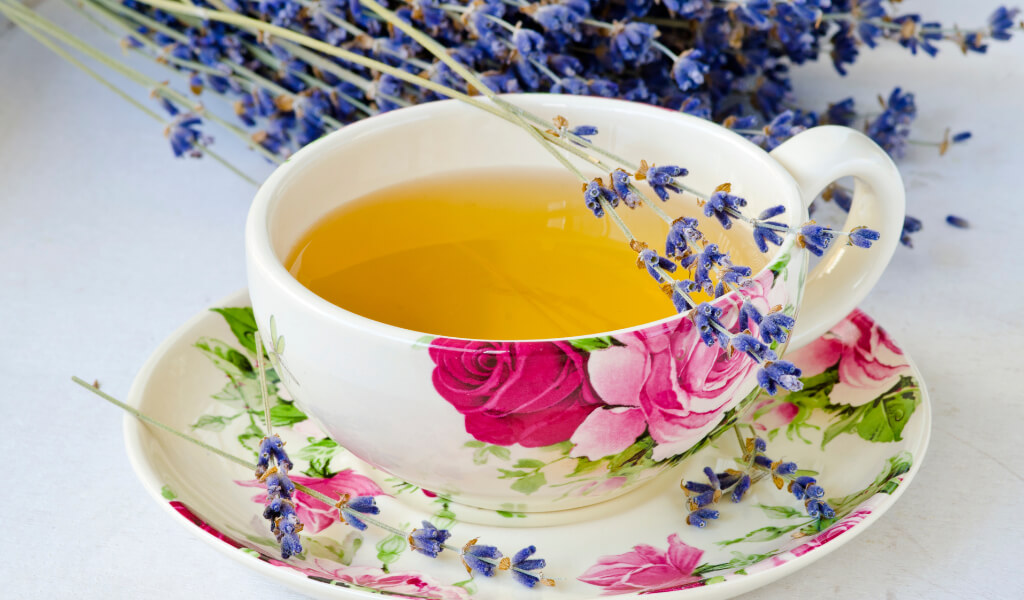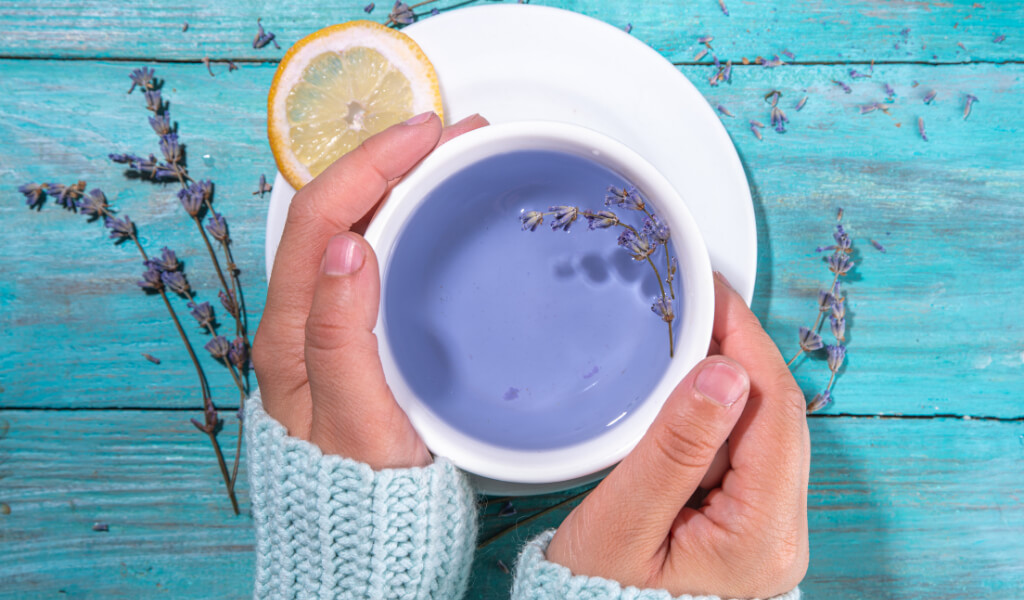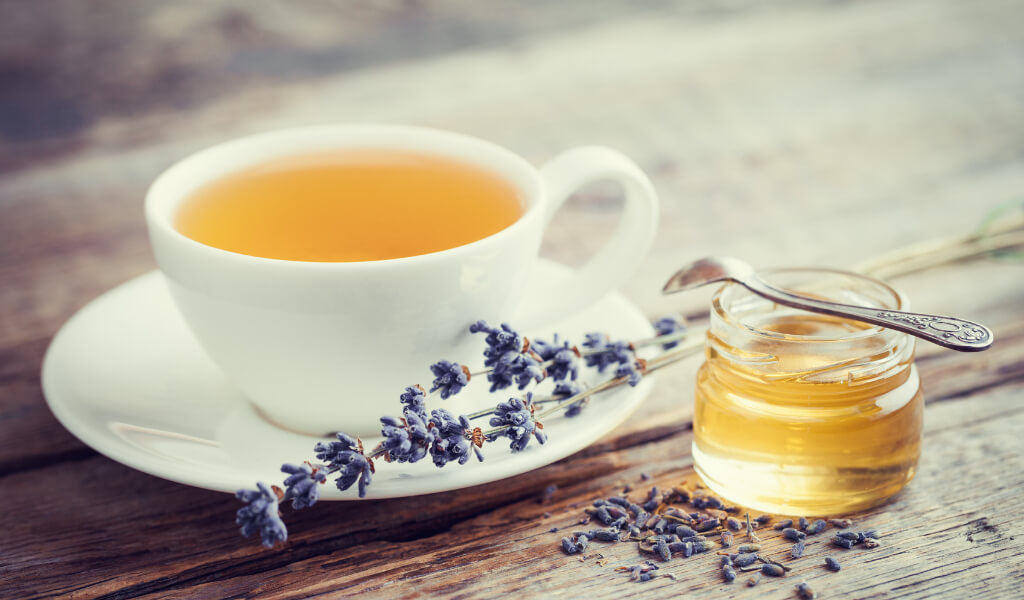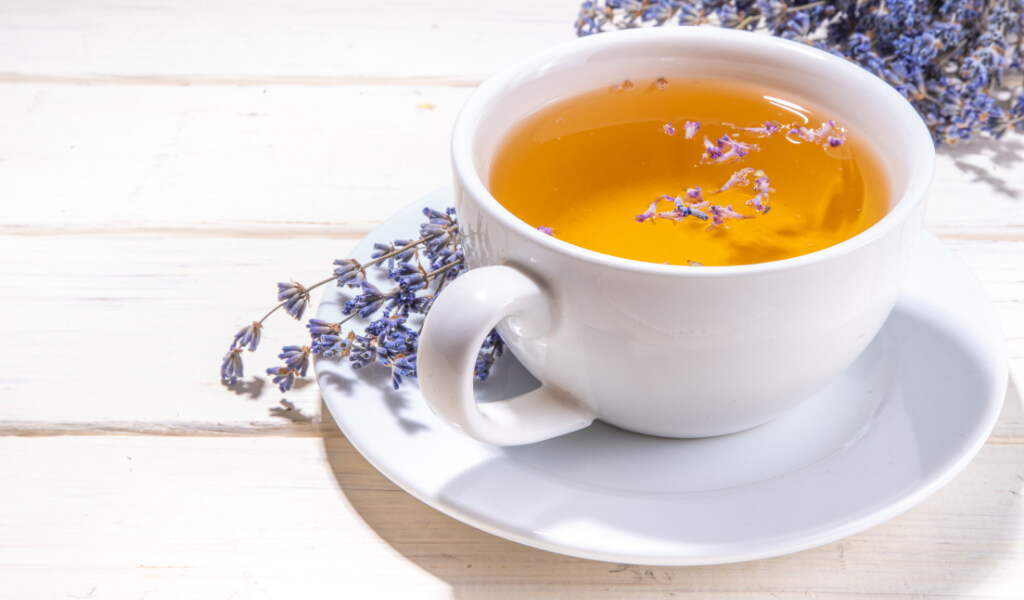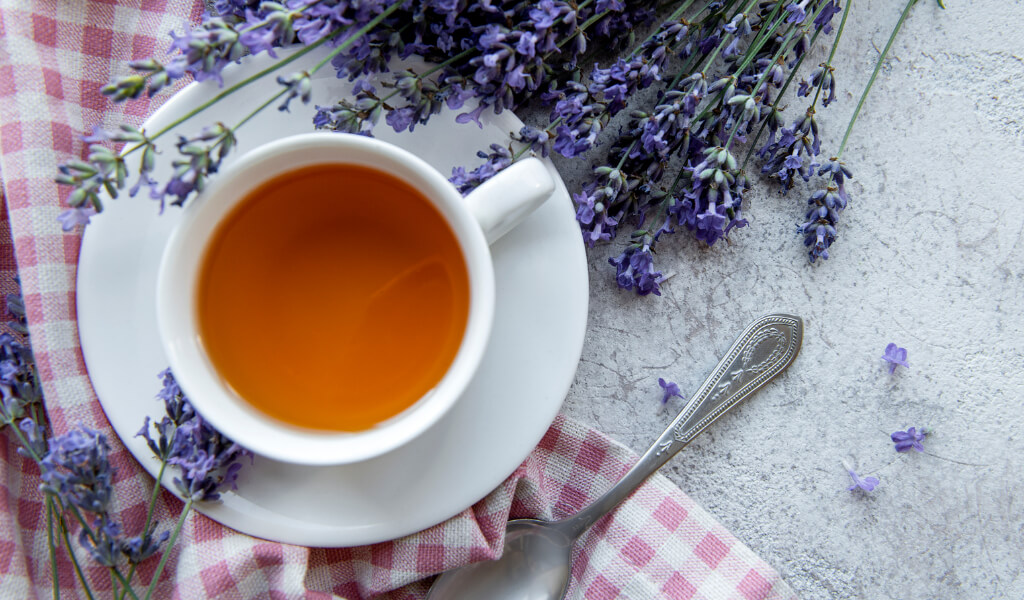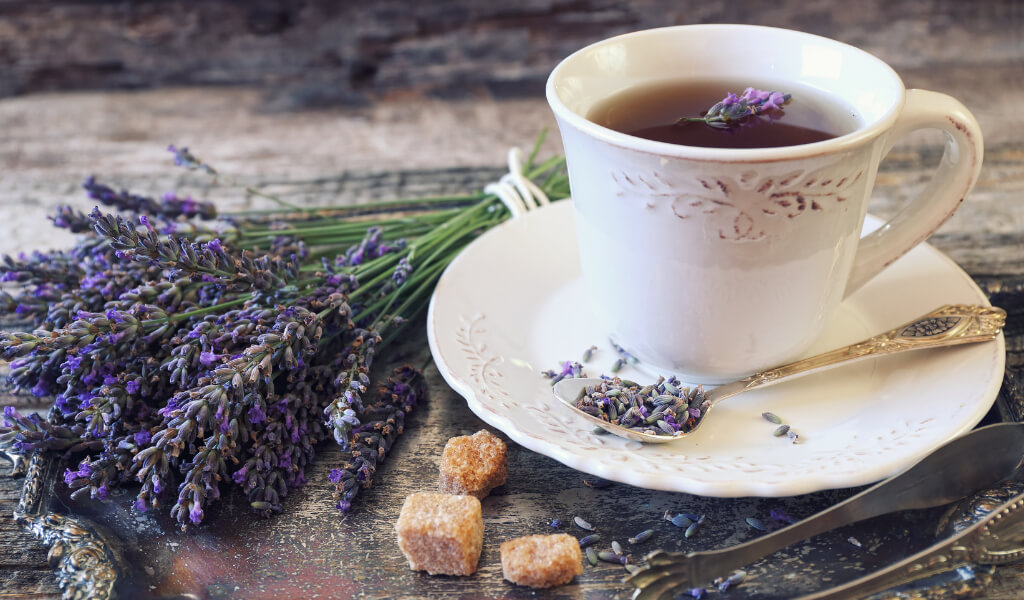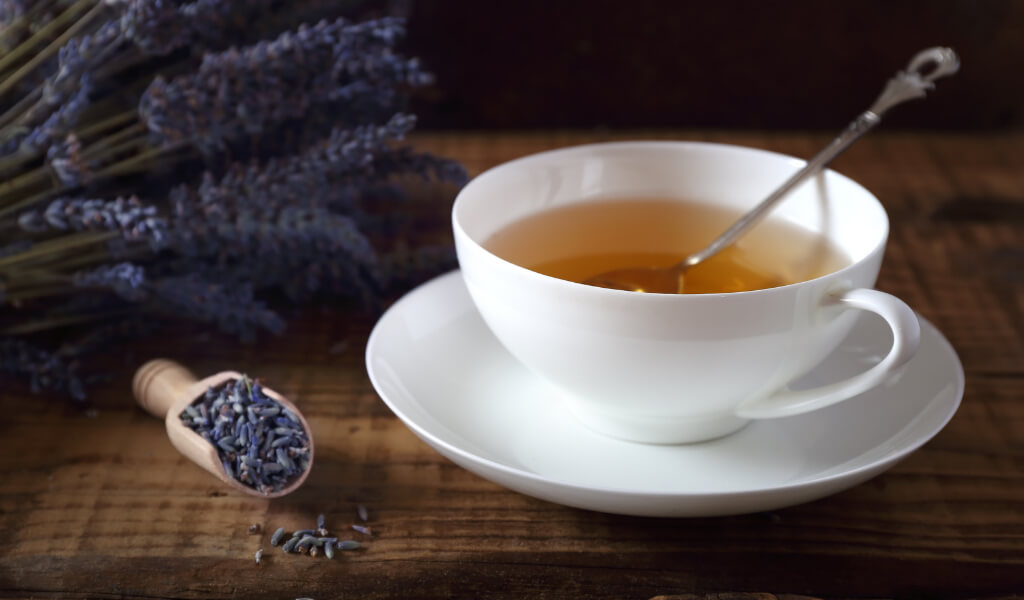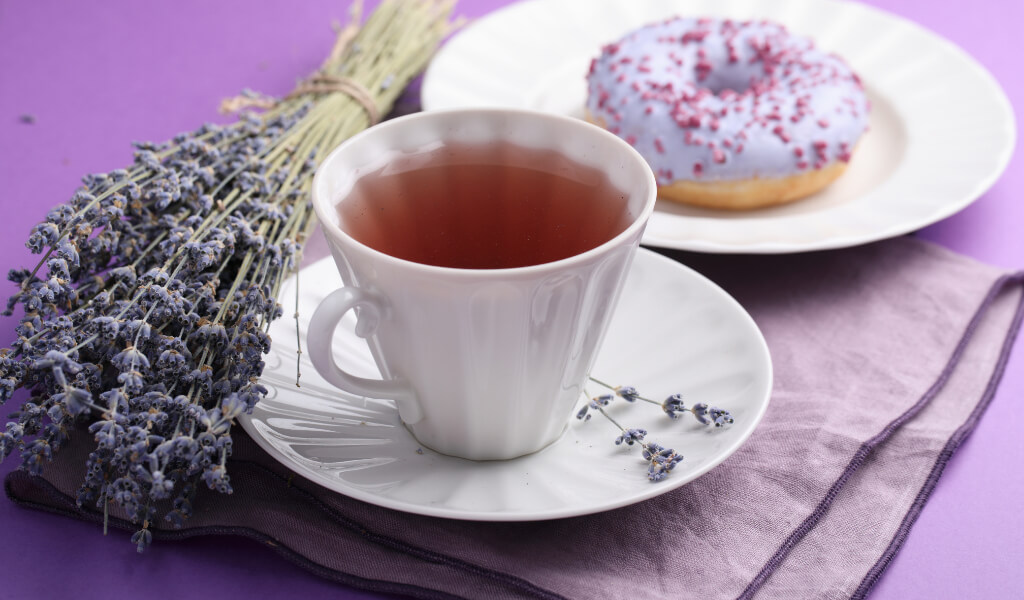Lavender tea, a soothing herbal drink, is derived from the buds of the Lavandula angustifolia plant, a species native to the Mediterranean.

Enjoyed for its calming properties and often associated with yoga practices, this aromatic tea is created from fresh or dried lavender buds.
English and French lavender, known for their purple flowers, are top choices for making lavender tea among the 40+ lavender species. The tea is naturally caffeine-free and has a delicate purple tint. Be sure to select food-grade lavender to avoid pesticides.
Beyond the realm of beverages, lavender’s versatile nature has found its place in various cosmetics and body care products, where it’s celebrated for enhancing skin health and reducing hair loss.
Flavor Profile
Lavender tea is a flavorful blend of sweet, floral, and earthy tones with subtle hints of rosemary and mint. Its complex profile may also feature undertones of smokiness or woodiness, and some variants even touch upon the fresh notes of green apple and rose, evoking similarities to green tea.
This rich combination of flavors is further enhanced by the tea’s distinctively relaxing, intense, and almost minty aroma, presenting an aesthetic as appealing to the senses as the tea’s visual color.
How to make lavender tea with lavender
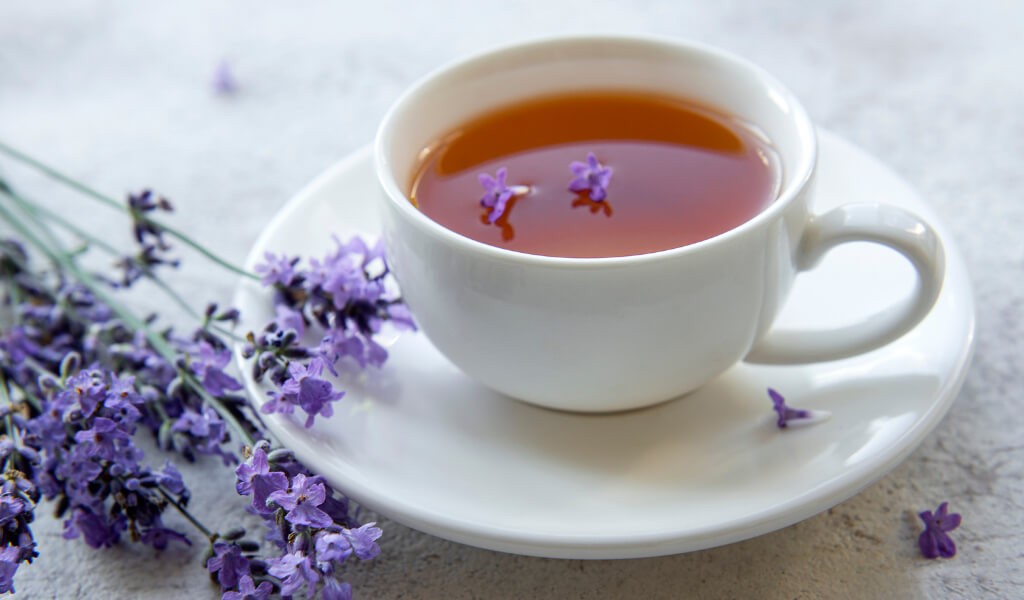
So, how do you make lavender tea? You will need a few simple ingredients and tools to craft a homemade lavender tea.
The magic begins with two teaspoons of fresh or dried lavender flowers for tea or leaves and two cups of water.
Add elements like lemon, honey, or a dash of your favorite iced tea for a personalized twist.
When it comes to brewing, precision is key. The optimal temperature is 100°C or 212°F, and steeping the lavender for about 5 minutes unlocks its full aromatic potential.
Step-by-step instructions.
Fresh tea lavender
- Gather two teaspoons of fresh lavender flowers or leaves.
- Boil two cups of water in a kettle.
- Place the fresh lavender in a tea infuser or teapot.
- Pour the boiling lavender water over the fresh lavender and let it steep for about 5 minutes.
- Strain the tea into your cup and enjoy it hot. You can add honey or lemon to taste.
Dried Lavender Tea
- Measure two teaspoons of dried lavender flowers or leaves.
- Bring two cups of water to a boil.
- Add the dried lavender to a tea infuser or teapot.
- Pour the boiling water over the dried lavender, allowing it to steep for approximately 5 minutes.
- Strain and serve the tea hot. Feel free to customize with additions like honey or lemon.
My tricks for Lavender Tea recipe
Creating the perfect cup of lavender tea is an art – experiment with the recipe and make it uniquely yours.
From my tea brewing journey, here are some useful tips on how to achieve the best possible cup of lavender tea:
Quality Matters: Always opt for loose lavander tea blends over tea bags. Loose lavender flowers, fresh or dried, offer a fresher flavor and generally contain higher-quality buds than pre-packaged tea bags.
Organic is the Way to Go: If you’re fortunate to have a garden for your lavender drink, go organic to prevent harmful chemicals from affecting your tea. I grow my lavender away from roads to avoid pollution.
Versatility of Lavender: Lavender tea can be brewed with black tea for a flavor boost. Add a tea sachet or 1 ½ teaspoons of loose black tea. I find that lavender pairs wonderfully with Earl Grey or chamomile tea.
Less is More: The most important tip is to stay moderate with the lavender buds. Adding more for an intense flavor is tempting, but the resulting taste can be overpoweringly strong and less pleasant to drink.
Sweeten to Taste: Whether you prefer hot or iced lavender tea, it can be enjoyed without sugar or milk. However, if you prefer a hint of sweetness, use simple syrup, which dissolves easily. You could even experiment with simple homemade syrups for a personal touch.
No Fear of Over-Steeping: Unlike other teas, such as green tea, lavender tea from leaves doesn’t turn overly bitter if brewed for 5 minutes. This is a huge relief, especially when I lose track of time!
Proper Storage: Finally, lavender tea can be brewed and stored in the refrigerator for up to 4 days. I prefer to keep it in an airtight glass container or pitcher to maintain its freshness.
Remember, brewing the perfect cup of lavender tea is a personal journey. Explore and experiment with different techniques until you find what suits your taste best. Happy brewing!
Read More:
- Red Clover Tea Benefits Weight Loss
- What Are The Key Oregano Tea Benefits & Side Effects
- Figure Out 10 Licorice Tea Benefits & Main Side Effects
- Benefits of Rrose hips tea: Rich in antioxidants
- 11 Main Benefits of Palo Azul Tea for overall Heath
- 6 Main Vervain Tea benefits You must not ignore
- Where does tea come from?
What Are The Lavender Tea Health Benefits
Lavender tea – Known for its calming effects, it can relieve stress and promote better sleep, making it an organic remedy for those restless nights. From enhancing the immune system to easing anxiety symptoms, lavender tea encapsulates many benefits contributing to overall well-being.
Lavender for sleeping
Does lavender help sleep? Many research have been conducted to demonstrate the benefit of lavender on sleep quality. Lavender enhanced sleep quality in fifteen healthy students, sixty-four heart disease patients, and thirty-four middle-aged women with insomnia. These components boost dopamine production and reduce the stress hormone cortisol, improving sleep quality and duration.
This hormonal balance fosters deep slow-wave sleep, the most vital sleep phase.
Another study among new mothers found that those inhaling lavender fragrance four days a week for eight weeks experienced significantly better sleep quality than those in the placebo group.
Similarly, college students with sleep issues reported improved sleep quality after practicing good sleep hygiene and breathing in lavender.
Decreases Inflammation
Equally remarkable, the anti-inflammatory properties of lavender tea are attributed to its abundance of antioxidants and polyphenols. These bioactive compounds help reduce inflammation, decreasing the risk of heart attacks by preventing blood clots in inflamed arteries. Furthermore, they offer pain relief by minimizing inflammation in muscles and joints.
The soothing scent of lavender also plays a role, helping to minimize muscle spasms, making lavender tea a valuable addition to your daily routine for overall wellness.
Enhances Immune Function
Brimming with antioxidants and antibacterial compounds, lavender tea is a natural bulwark, fortifying the immune system against common ailments like colds and flu.
Abundant in nutrients such as vitamin C, calcium, and magnesium, this herbal drink aids the body in warding off bacterial, fungal, and viral infections, thus amplifying immune health.
Preliminary research even suggests potential immune-strengthening properties of lavender, pointing towards its role in overall disease prevention.
Purifies the Body
In addition, lavender tea is a detoxifying agent, ridding the body of harmful toxins. The antioxidants present in the tea neutralize free radicals – harmful molecules generated from environmental pollutants, excessive alcohol consumption, and smoking.
These free radicals can induce oxidative stress, leading to cellular mutation or degradation, and are implicated in cancer development and aging. Thus, lavender tea effectively combats such health risks by eliminating free radicals.
In essence, lavender tea’s immune-boosting and detoxifying properties make it a pleasing drink and a potent health ally.
Promotes Digestive Well-being
Packed with anti-inflammatory properties, lavender tea plays a crucial role in supporting digestive health.
It eases a range of digestive discomforts, from diarrhea and nausea to stomach cramps, thanks to its antispasmodic effects, which alleviate indigestion, gas, and bloating. Lavender’s fragrance aids digestion as well, stimulating bile production for efficient food breakdown and helping to control nausea through its calming scent.
Assists Respiratory Well-being
Lavender tea also bolsters respiratory health. It can relieve those suffering from breathing problems by relaxing inflamed muscles in the throat and chest, thus facilitating easier breathing. Further, lavender tea’s antibacterial qualities help combat bacteria causing chest colds and congestion.
EASE MENSTRUAL PAIN
Lavender tea, acknowledged for its soothing properties, is also a beneficial relief for menstrual cramps.
Studies indicate its profound influence in alleviating period discomforts, primarily owing to its anti-spasmodic and anti-inflammatory characteristics.
In a study involving 200 young adult women in Iran, a daily regimen of inhaling lavender aroma for 30 minutes during the initial days of their menstrual cycle resulted in noticeably less painful cramping after two months, suggesting lavender’s potential as a natural remedy for menstrual pain.
Safeguards Skin Against Fungal Infections
Lavender tea’s benefits extend to skin health, specifically protecting against fungal infections. It supports the treatment of various skin ailments by harnessing its inherent anti-inflammatory qualities.
Topical application of lavender oil, as highlighted in a study on rats, significantly decreased wound area compared to the control group over 14 days. It promotes swift healing, reduces inflamed rashes, and even helps diminish scars from acne.
Moreover, it aids in skin rejuvenation by potentially stimulating collagen production, pointing to lavender tea as a promising component for skin restoration.
Alleviates Symptoms of Anxiety
Characterized by fear, apprehension, and worry, anxiety can manifest in physical symptoms such as an increased heart rate, sweating, and shaking.
Lavender tea’s therapeutic benefits, rooted in its calming aroma, could effectively soothe these symptoms. Its soothing fragrance is believed to stimulate the brain to secrete serotonin, often called the ‘feel-good hormone,’ while concurrently reducing stress-related cortisol levels.
In one study, participants who ingested lavender tea twice daily over four weeks reported decreased stress and anxiety levels. Regular consumption of lavender tea contributes to inducing relaxation, improving moods, and even offering anti-depressant qualities.
Facilitates Wound Recovery
The oil derived from lavender is known for its exceptional antibacterial and antiseptic properties, making it an effective agent in wound care. Topical application of lavender oil onto wounds aids in timely healing by killing bacteria, preventing infection and promoting tissue repair.
Furthermore, lavender oil has been shown in studies to promote collagen synthesis, an essential protein for skin regeneration, underscoring its potential in effective wound management.
Lavender tea could speed up the healing process and reduce scarring when used in wound care routines.
Lavender Tea’s Potential Benefits for Acid Reflux
For those grappling with acid reflux, characterized by the unwelcome intrusion of stomach acid into the esophagus due to excessive relaxation of the lower esophageal sphincter (LES), lavender tea might offer a respite.
Dietary or lifestyle factors, such as overeating or indulging in high-fat or acidic foods, typically trigger this condition, manifesting in symptoms like chest pain, heartburn, and regurgitation.
Lavender tea, laden with antispasmodic compounds, can fortify the LES, assisting it to remain constricted, thereby preventing stomach acids from surging into the esophagus.
A 2017 study further underscores lavender tea’s potential in reducing nausea linked to acid reflux.
Lavender Tea Benefits for PCOS
Simultaneously, lavender tea might offer tangible benefits for women dealing with Polycystic Ovary Syndrome (PCOS), a hormonal disorder marked by an imbalance in female hormones, especially elevated androgen levels.
PCOS manifests in symptoms like irregular periods, infertility, and weight gain. Lavender, laden with anti-androgenic compounds, could potentially alleviate these symptoms.
A 2018 study posits that when ingested or applied topically, lavender oil could reduce androgen levels in PCOS patients. Furthermore, the anxiety and stress relief that lavender tea offers could aid in managing common side effects of PCOS.
Side Effects of Lavender Tea
Hormone Effects
Lavender has been associated with hormone-related side effects, specifically for prepubescent males and pregnant women.
For prepubescent males, the consumption of lavender tea has been linked to gynecomastia, a condition characterized by an increase in breast tissue. This side effect is generally reversible by discontinuing the use of lavender.
As a result, experts advise moderating lavender tea consumption for boys who haven’t undergone puberty yet.
For pregnant and breastfeeding women, caution is advised due to lavender’s potential estrogen-mimicking properties.
Allergies
Another potential side effect of consuming lavender tea involves allergic reactions. Individuals with allergies to lavender or related plants might experience adverse reactions, including difficulty breathing, skin rashes, or throat irritation. Hence, if you’re sensitive to such allergies, avoiding lavender tea is best.
Proper Dosage
The proper dosage of lavender is a critical consideration when brewing lavender tea. While some sources might recommend using a lavender essential oil, it’s essential to remember that these oils are highly concentrated. Therefore, consumption should be under the guidance of a licensed aromatherapist to avoid negative side effects.
Other Potential Side Effects
Lavender tea may cause other side effects in rare cases, including abdominal discomfort, headaches, increased appetite, and sleep disturbances. Additionally, those allergic to other herbs, such as chamomile or thyme, might also be at risk of a reaction when drinking lavender tea.
There’s also been a report of an abnormally rapid heartbeat after consuming lavender tea, highlighting the need for caution, particularly if you have any underlying heart conditions.
In conclusion
Lavender tea is a remarkable natural remedy with many potential health benefits. It offers an impressive range of therapeutic qualities, from promoting relaxation and sleep to relieving menstrual pain and aiding in digestion.
However, as with any herbal supplement, it’s crucial to be aware of the potential side effects and consume it responsibly.
If you enjoy herbal teas and are seeking a new addition to your routine, lavender tea may be worth considering.
Remember to check with your healthcare provider, especially if you’re pregnant, breastfeeding, or have any existing medical conditions.
Thanks from Spiriteadrinks.com
FAQs
Can you use lavender leaves for tea?
Yes, you can use lavender leaves for tea. They can be used fresh or dried, providing a more subtle flavor than lavender flowers. The process is as simple as brewing any other loose leaf tea.
When to harvest lavender for tea for a more flavorful tea?
The best time to harvest lavender for tea is mid-summer when the flowers bloom. This is when they have the highest concentration of essential oils, providing a more celestial taste to your brew.
What’s the recommended way to dry lavender for tea?
To dry lavender for tea, simply cut the flower stalks, bundle them together, and hang them upside down in a dry, airy place away from direct sunlight. Once dried, the lavender can be used similarly to other Teavana or earl gray loose-leaf teas.
Can you eat lavender flowers?
Both the blooms and the leaves are edible, with a pleasant yet somewhat bitter flavor. Lavender may grow in southern Europe, Australia, and the United States. Dried lavender has few calories per tablespoon and is fat and cholesterol free.
What part of lavender is primarily used for tea?
The flower buds of the lavender plant are primarily used for tea. These buds, once dried, can be used just like any other Hemani or Lipton loose leaf tea. The buds infuse a robust flavor and a soothing aroma into your tea, making it a relaxing beverage.
How long to steep lavender tea?
Lavender should typically steep in tea for about 5 to 10 minutes. This allows enough time for the flavor and essential oils to infuse into the water, resulting in a brew similar to other loose-leaf teas such as Earl Gray or Lipton.
what part of lavender is used for tea?
The most frequent way to consume lavender is to make a tea from its buds. Making lavender tea helps to release the oils and smells. They are often used in cooking, as a garnish or infused in beverages like tea, providing a unique aroma and flavor similar to Hemani herbal products..
How much lavender for tea?
Because lavender leaves are not utilized to make tea, only the flower buds should be kept. For every eight-ounce cup of water, use around two tablespoons of lavender buds. For dried flower kinds, use just one spoonful. For dried flower kinds, use just one spoonful.
I’m Shanna, creator of Spiritea Drinks. I’m all about teaching people to grow their own food, tea, cook what they harvest, and eat with the seasons.

